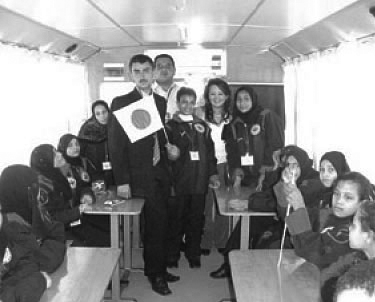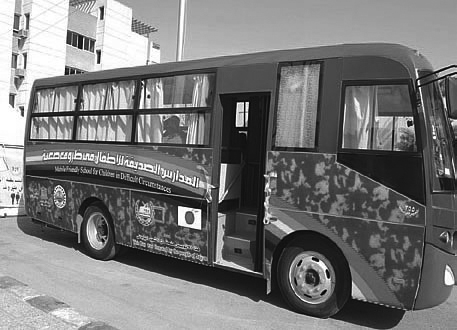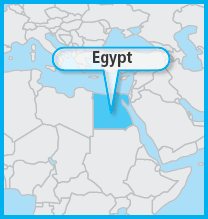Japan's Official Development Assistance White Paper 2009
Column 2 School Has Arrived!
— "Mobile Schools" in Egypt —
"Here, everyone has everything to study." Children who had been selling items on the street just a few hours ago, smiled. The place where they take classes is slightly different from the usual image that people have for a school. Their classroom is a bus fitted with desks, chairs, and a blackboard. This "mobile school" was realized through assistance from Japan*1, and it is run by the United Nations Educational, Scientific and Cultural Organization (UNESCO) in cooperation with the Egyptian government.
While Egypt has achieved steady economic growth in recent years, but an increasing number of poor people is being left behind. The number of children who have to work in order to live or have to live on the streets because of their family situation is said to be over 1 million in Egypt, and most of them are unable to go to school. In response to this problem, the Egyptian government, UNESCO, NGOs, and others have jointly started a "friendly schools" project to give classes to street children in locations other than schools.
"Mobile schools" is one part of this project, and Ms. Mikako Moriya of the UNESCO Cairo Office has played a key role in its realization. Ms. Moriya, who work experience in Egypt in the past as a Japan Overseas Cooperation Volunteer, and is proficient in Arabic, went back and forth between the Japanese Embassy, UNESCO, and the Egyptian government and spoke with the relevant persons about the project's content, funding, and so forth. She was able to get assistance from UNESCO regarding the teaching materials and so forth, assistance from the Egyptian government and NGOs regarding the teachers and staff, and assistance from Japan regarding the "mobile school" classroom bus and classroom materials.
At the planning stage for the "mobile school" bus, Ms. Moriya had the idea of painting the outside of the vehicles with a seven-color rainbow. "I thought that the children would be attracted by the beauty of the rainbow, and get on the bus" she recalls. As expected, children have gathered at the "mobile schools." Now, children from ages 8 to 14 who had never been to school before wait for the school to come by each week.
The "mobile schools" teach the same subjects as in regular elementary schools, and they also teach weaving, woodwork, and other skills for the children who have to work. When Ms. Moriya asks these children who have gained confidence thanks to these attentive classes," what they become in the future", they give responses with their eyes light up like "I want to become a teacher!" "I will become a policeman!" and "My dream is to become an actress!"
Ms. Moriya says, "I have given attention to how the people of Egypt can make the 'mobile schools' their own project." Ms. Moriya served as a liaison so that people of Egypt, UNESCO and Japan could work together. An additional effort was made by her to encourage the domestic and foreign media to give coverage of the "mobile school," and to boost awareness among the relevant people in Egypt as well as their motivations.
Now that the "mobile schools" are running smoothly, Ms. Moriya says positively, "I intend to support efforts such as 'mobile schools' for as many children as possible so that their hearts are colored with a rainbow of hope."
*1 Grant assistance for grassroots human security projects.

Children in a "mobile school." (Ms. Moriya is on the center right.)

"Mobile school" designed by Ms. Moriya.

